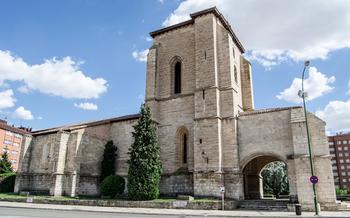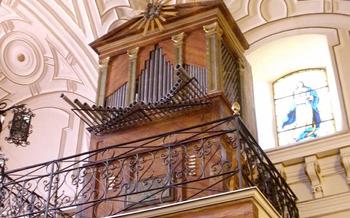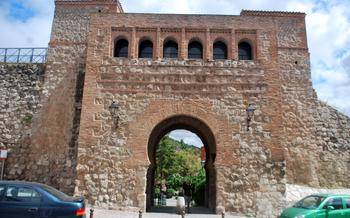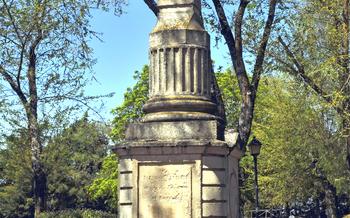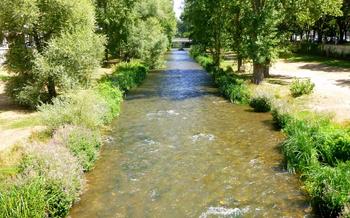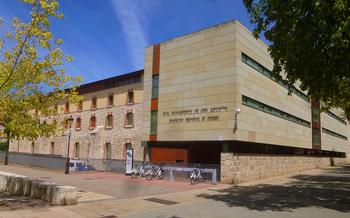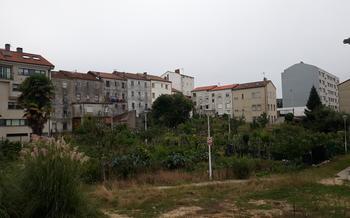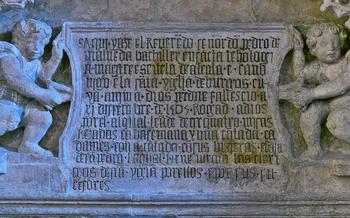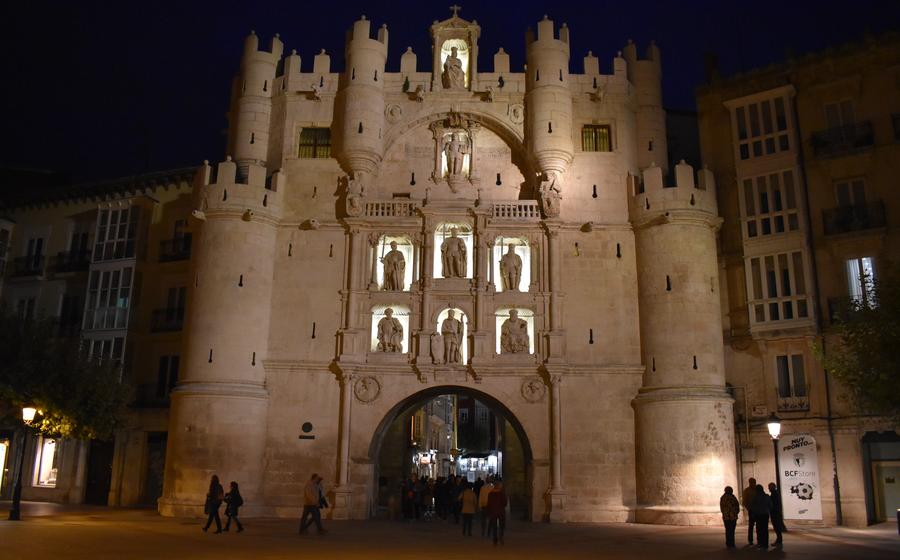
Arco de Santa María
- A City of History and Heritage
- Arco de Santa María - A Symbol of Strength
- Exploring the Arch's Exterior
- Stepping Through the Archway
- Landmark on the Camino de Santiago
- Gateway to Burgos Cathedral
- Architectural Masterpiece
- Best Time to Visit
- Accessibility and Transportation
- Nearby Attractions
- Photography Tips
- Insider Tip: Experience the Medieval Market
A City of History and Heritage
Burgos, a city in northern Spain, boasts a rich history and a diverse architectural heritage. Founded in the 9th century, it was once the capital of the Kingdom of Castile and played a crucial role in the Reconquista, the Christian reconquest of the Iberian Peninsula from Muslim rule.
The city's architectural landscape reflects its long and storied past. From the Gothic spires of its iconic cathedral to the Renaissance grandeur of the Casa del Cordón, Burgos showcases a harmonious blend of architectural styles. Several UNESCO World Heritage Sites, including the Burgos Cathedral and the Atapuerca Mountains, further attest to the city's cultural and historical significance.
Among the must-see landmarks in Burgos is the Arco de Santa María, a triumphal arch that stands as a testament to the city's resilience and its enduring spirit.
Arco de Santa María - A Symbol of Strength
The Arco de Santa María prowess. Its origins can be traced back to the 14th century, when it was constructed as the main gate to the city. The arch was designed by renowned architect Juan de Colonia and completed in 1566, reflecting the transition from Gothic to Renaissance architectural styles. The arch's design is characterized by its pointed Gothic arches, intricate carvings, and Renaissance-inspired ornamentation, creating a harmonious blend of architectural styles. Its imposing structure and ornate details showcase the skill and artistry of the craftsmen who built it. The arch serves as a gateway to the city center, welcoming visitors and pilgrims alike to explore the wonders of Burgos.
Exploring the Arch's Exterior
Admire the intricate stone carvings that adorn the archway, each one a testament to the skill and craftsmanship of the builders. Look for the statue of the Virgin Mary, the patron saint of Burgos, as well as the city's coat of arms, which features a castle and a lion.
The arch serves as a passageway to the city center, inviting visitors to step through and discover the vibrant Plaza Mayor. Take a moment to appreciate the arch's grandeur and the history it holds before venturing into the heart of Burgos.
Stepping Through the Archway
As you step through the grand archway of Arco de Santa María, you enter the vibrant heart of Burgos, the Plaza Mayor. This bustling square is a hub of activity, where the city's past and present intertwine. The air is filled with the sounds of vendors hawking their wares, the laughter of children playing, and the melodies of street musicians.
The Plaza Mayor, also known as the Plaza del Mercado, has served as the city's main market square for centuries. Here, you can browse stalls selling fresh produce, local delicacies, and handmade crafts. The square is also home to several historic buildings, including the Casa del Cordón, a 15th-century palace that now houses the city's archives.
In the center of the square stands a majestic fountain, the Fuente del Rey San Fernando, which depicts the city's patron saint, King Ferdinand III. Surrounding the fountain are numerous restaurants and cafés, where you can relax and soak up the lively atmosphere.
During the summer months, the Plaza Mayor comes alive with cultural events and performances. From concerts and dance shows to theater productions and art exhibitions, there is always something to entertain and engage visitors. Whether you're looking to shop, dine, or simply soak up the vibrant atmosphere, the Plaza Mayor is a must-visit destination in Burgos.
Landmark on the Camino de Santiago
The Arco de Santa María holds that attracts millions of travelers each year. For centuries, pilgrims from all corners of Europe have journeyed along this ancient path, seeking spiritual enlightenment and guidance. The arch serves as a symbolic gateway for these pilgrims, marking their entry into the city of Burgos, a major stopover on the route.
As pilgrims approach the arch, they are greeted by the imposing sight of this architectural marvel. The arch becomes a beacon of hope and inspiration, reminding them of the challenges and rewards that lie ahead on their journey. The arch's intricate carvings and sculptures offer a glimpse into the rich history and cultural significance of the Camino, further enhancing the pilgrims' spiritual experience.
For many pilgrims, passing through the Arco de Santa María is a deeply emotional and transformative moment. It symbolizes their commitment to the pilgrimage and their willingness to embrace the challenges that await them. The arch becomes a symbol of guidance and protection, as pilgrims seek divine intervention and support for their journey.
Throughout the centuries, countless stories and legends have emerged from pilgrims who have passed through the Arco de Santa María. Tales of miracles, divine encounters, and personal transformations abound, adding to the mystique and allure of this historic landmark. Whether you are a devout pilgrim or simply a traveler seeking a glimpse into the past, the Arco de Santa María stands as a testament to the enduring spirit of the Camino de Santiago.
Gateway to Burgos Cathedral
The Arco de Santa María stands in close proximity to the iconic Burgos Cathedral, one of the most magnificent Gothic cathedrals in Spain. The arch serves as a symbolic and architectural prelude to the grandeur that awaits visitors within the cathedral's hallowed walls. The two landmarks are inextricably linked, forming a harmonious ensemble that showcases the city's rich artistic heritage.
A combined ticket for both the arch and the cathedral is available, offering visitors a comprehensive and immersive experience. This ticket grants access to the arch's historical exhibits, allowing visitors to delve deeper into its significance and symbolism. The cathedral, with its soaring spires, intricate stained glass windows, and awe-inspiring interior, is a testament to the architectural prowess of the medieval era.
Stepping through the Arco de Santa María and into the cathedral's embrace, visitors are transported back in time, surrounded by centuries of history and artistry. The arch serves as a gateway to a realm of wonder and inspiration, where the sacred and the secular converge, leaving an indelible mark on the hearts and minds of all who pass through its portals.
Architectural Masterpiece
The Arco de Santa María showcases a harmonious blend of Gothic and Renaissance architectural styles. Its Gothic origins are evident in the pointed arches, ribbed vaults, and flying buttresses, which create a sense of height and grandeur. The Renaissance influence is seen in the intricate details, sculptures, and decorative elements that adorn the arch.
The arch features exquisite carvings and sculptures that depict religious figures, mythical creatures, and scenes from the Bible. These intricate details add depth and symbolism to the arch, making it a true work of art. The arch's symbolism extends beyond its religious significance, as it also represents the city's strength, resilience, and cultural heritage.
The arch's design is not merely ornamental; it also serves a functional purpose. The pointed arches and flying buttresses distribute the weight of the structure, ensuring its stability and durability. The arch's construction is a testament to the engineering prowess of its builders, who created a structure that has stood the test of time.
Overall, the Arco de Santa María is an architectural masterpiece that combines beauty, symbolism, and functionality. Its Gothic and Renaissance influences make it a unique and captivating structure that attracts visitors from around the world.
Best Time to Visit
Timing your visit to the Arco de Santa María can greatly enhance your experience. To avoid the sweltering summer heat and large crowds, plan your trip during the shoulder seasons of spring (April-May) or autumn (September-October). These months offer pleasant weather, allowing you to comfortably explore the arch and its surroundings.
Additionally, Burgos hosts several events and festivals throughout the year. The city's annual medieval market, held near the arch, is a highlight. This vibrant event transports you back in time with traditional costumes, food, music, and performances. Immerse yourself in history and revel in the lively atmosphere.
To fully appreciate the arch's intricate details and grandeur, visit during the golden hour, just before sunset. The warm light casts a magical glow on the stone carvings, creating stunning photo opportunities. Alternatively, early morning offers a serene and tranquil ambiance, allowing you to soak in the arch's beauty without the hustle and bustle of the day.
No matter when you choose to visit, the Arco de Santa María stands as a timeless symbol of Burgos' rich history and cultural heritage, waiting to be explored and admired.
Accessibility and Transportation
The Arco de Santa María is conveniently located in the heart of Burgos, making it easily accessible by various modes of transport. Numerous public transportation options, including buses and taxis, stop nearby, providing seamless connectivity to different parts of the city. For those traveling by car, there are several parking garages within walking distance, ensuring hassle-free parking. The arch is also wheelchair accessible, with ramps and elevators facilitating easy access for visitors with mobility challenges. Additionally, the area around the arch is pedestrian-friendly, offering a pleasant and safe environment for those who prefer to explore on foot or by bicycle.
Nearby Attractions
The Arco de Santa María stands as a gateway to a wealth of cultural and historical treasures that Burgos proudly holds. In the immediate vicinity of the arch, visitors can immerse themselves in the vibrant Plaza Mayor, the city's main square. This lively hub is lined with charming cafes, traditional restaurants, and shops, creating a bustling atmosphere that encapsulates the essence of Spanish culture.
Just a short stroll from the arch, the awe-inspiring Burgos Cathedral rises in all its Gothic glory. This UNESCO World Heritage Site is a masterpiece of architectural prowess, showcasing intricate carvings, stunning stained glass windows, and an opulent interior that leaves visitors in awe. A visit to the cathedral's museum further enriches the experience, providing insights into the history, art, and religious significance of this sacred edifice.
For those fascinated by human evolution and the origins of our species, the Museum of Human Evolution offers a captivating journey through time. This state-of-the-art museum houses an extensive collection of fossils, interactive exhibits, and multimedia displays that shed light on the remarkable story of human evolution.
Finally, no visit to Burgos would be complete without a leisurely stroll along the Paseo del Espolón, a picturesque promenade that stretches along the banks of the Arlanzón River. This verdant oasis offers a tranquil escape from the city's hustle and bustle, providing a serene setting to admire the city's skyline, bask in the warm Spanish sunshine, or simply relax and soak in the beauty of the surroundings.
Photography Tips
The Arco de Santa María presents a captivating subject for photographers. To capture its grandeur effectively, consider the following tips:
-
Best Angles: Position yourself slightly to the side of the arch to showcase its height and intricate details. Experiment with different angles to find the most flattering perspective.
-
Lighting Conditions: The arch's beauty is enhanced during the golden hours of sunrise and sunset, when the warm light casts dramatic shadows and accentuates its textures.
-
Filters and Editing: Utilize filters and editing software to enhance the colors and contrast of your photos. Experiment with different settings to achieve the desired effect.
-
Share Your Photos: Share your stunning captures on social media using the hashtag #ArcoDeSantaMaria to connect with fellow enthusiasts and showcase the arch's beauty to the world.
Insider Tip: Experience the Medieval Market
For a truly immersive experience, time your visit to Burgos to coincide with the annual medieval market held near the Arco de Santa María. This vibrant event transports you back in time, with vendors dressed in medieval attire selling traditional crafts, food, and beverages. Immerse yourself in the festivities by donning a medieval costume and joining in the celebrations. Enjoy live music, performances, and demonstrations that bring the era to life. This insider tip offers a unique opportunity to experience the rich history and culture of Burgos firsthand.

